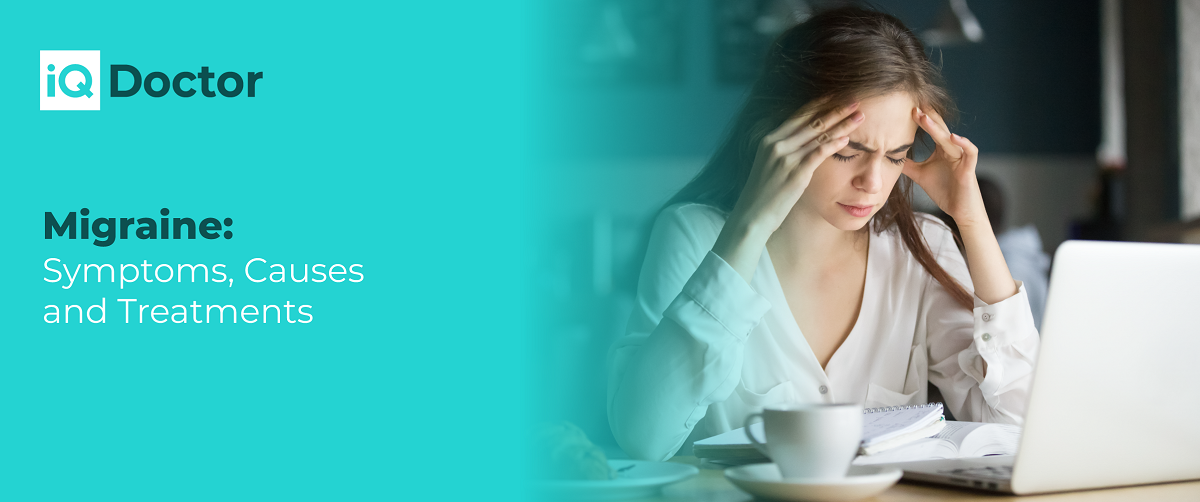Migraine: Symptoms, Causes and Treatments
02 June, 2022 | Holy Winter - Healthcare Writer

A migraine is a headache that usually affects one side of the head and causes extreme throbbing pain or a pulsing sensation. It's commonly accompanied by nausea, vomiting, and excessive sensitivity to light and sound. Migraine attacks can last anywhere from hours to days, and the pain might be severe enough to prevent you from going about your usual activities.
Symptoms of Migraine Attack
Migraines can affect people of all age groups and progress typically through four stages: prodrome, aura, attack, and post-drome. Initially, there are migraine symptoms without headache, and then there is the attack.
Prodrome
You may detect small changes that indicate an impending migraine one or two days before it occurs, such as:
Constipation
Changes in mood, ranging from sadness to exhilaration
Hunger pangs
stiffness in the neck
Urination is becoming more frequent.
Retention of fluid
Excessive yawning
Aura
Auras can appear before or during migraines for certain people. Auras are reversible nervous system symptoms. Visual disturbances are the most common. Each symptom starts typically slowly and grows up over several minutes, lasting up to 60 minutes.
The following are some examples of migraine auras:
Seeing visual disturbances such as shapes, bright spots, or flashes of light
Loss of vision
A tingling sensation in the arms or legs
Weakness or numbness on one side of the body or the face
Having difficulty talking
Attack
If the issue of migraines is left untreated, a typical migraine attack can last anywhere from 4 hours to 72 hours. The frequency with which a migraine attack will occur varies from patient to patient. Migraines can occur at a frequency that is as low as once per month to as high as multiple times in a single month.
You may have the following symptoms during a migraine:
Sharp pain on one side of your head, but it can also occur on both sides.
Throbbing pain in the scalp region.
A high level of sensitivity to light, sound, and sometimes to smell and touch.
Vomiting and nausea.
Post-drome
This is one of the post-migraine symptoms. You may feel tired, bewildered, and exhausted for up to a day after a migraine attack. Some people claim to be in a good mood after a migraine passes. Suddenly moving your head can reactivate the discomfort for a brief period.
When To See A Doctor
Migraines can remain undetected and improperly treated far too often. Keep track of your migraine attacks and remember the methods you have for successfully dealing with them if you suffer them regularly. The first step in getting treatment for migraines is to schedule a consultation with your health professional to get a prognosis for your migraine attacks.
Even if you've had severe headaches in the past, consult with your doctor to see if there is any change in the patterns or if your headaches feel any different now. If you experience of the following signs and symptoms with a migraine attack, it could signal a more serious health issue and requires immediate medical attention:
An intense, sudden headache, similar to a thunderclap
Headache along with a fever, a stiff neck, confusion, convulsions, double vision, numbness or weakness in any part of your body may indicate a stroke.
After getting a head injury, you start to experience headaches.
Causes of Migraine Attack
A migraine attack can have several triggers, such as:
Hormonal fluctuations for women. Many women experience headaches when their oestrogen levels fluctuate, such as before or during their menstrual cycles, during pregnancy, or menopause.
Oral contraceptives or other hormonal drugs. These can exacerbate the severity of a migraine. However, some women who use these drugs experience a reduction in the frequency of their migraines.
Certain beverages. Alcoholic drinks, particularly wine or coffee, are commonly consumed drinks that can trigger a migraine attack.
Stress. An often reported trigger for Migraines is an attack brought on by stress at work or at home.
Changes in sleeping patterns. Getting too little sleep or too much, as compared to your usual amount of sleep, can trigger migraines among some patients.
Physiological factors. For some patients with migraines, an attack can be triggered by strenuous physical activity, which can include vigorous sexual activity.
Changes in the weather. A change in temperature or barometric pressure, especially if it is a sudden change, can trigger migraines for some people.
Medications. Certain medications, such as the above mentioned oral contraceptives and other medicines like vasodilators (such as nitroglycerin), can trigger migraines among some patients.
Certain food items. A Migraine may be triggered by foods such as aged cheese or processed and salty foods. Skipping a meal could have the same effect.
Food additives. Many food products contain the artificial sweetener aspartame and the preservative monosodium glutamate (MSG), which can trigger migraine attacks in some people.
Factors linked to Migraines
There are a few risk factors that can increase or decrease your chances of suffering from migraines. These include:
A family history of migraines. The prevalence of migraine attacks among near and extended families can indicate an increased risk of developing a migraine problem yourself.
Age. Migraines can start to occur at any age, although they tend to be observed most frequently during the age of puberty. The age window for experiencing migraine peaks during the thirties. After that, the risk of migraines reduces in severity and frequency over the later decades.
Gender. Women are three times as likely to suffer from migraines than men are.
Hormonal changes. As mentioned before, migraine headaches can start being a common problem before or shortly after menstruation among women. Women are also at increased risk of experiencing migraines while they are pregnant or when going they are going through menopause. Most women with migraines will see a gradual reduction in the severity and frequency of migraines after they have passed menopause.
Treatments of Migraine
The treatment for Migraine involves either lessening the symptoms of a migraine or preventing any migraine attacks from occurring in the first place. Medications for migraines belong to two broad categories.
The first category is pain relief medications. These medications are known as acute or abortive treatments for migraines, and they are meant to be taken while a migraine attack is ongoing. The purpose of pain relief migraine medications is to reduce the pain and severity of an ongoing migraine attack.
The second type of migraine medication is preventative medication. These are intended to reduce the frequency with which migraines occur in the first place or to stop them from occurring at all. This type of migraine medication works best when it is taken daily, whether the patient gets a migraine or not.
Although rare, there can be side effects of migraine medications. Therefore, you should always consult a health expert first. After considering the severity and frequency of existing migraines, they will determine the type of medication that you should take. The health expert will also need to consider any symptoms that accompany migraine attacks, such as nausea or vomiting, along with any other relevant health issues.
Reviewed By

Omar El-Gohary
The superintendent and lead pharmacist - registration number 2059792.
Omar is passionate about developing healthcare technology to empower our patients.


